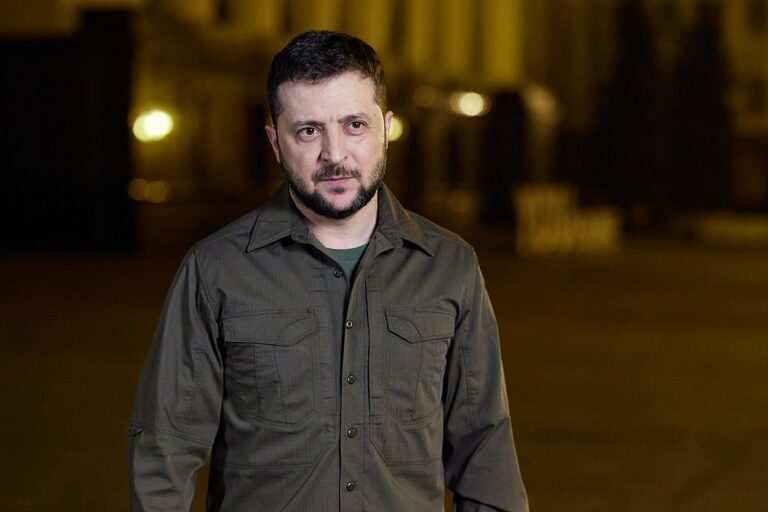
This article was originally published by Radio Free Europe/Radio Liberty and is reprinted with permission.
Russian air strikes pounded Kyiv and other cities across Ukraine overnight, killing several people and wounding dozens of others — including a pregnant woman — as Moscow continues to hit civilian infrastructure.
President Volodymyr Zelenskyy said Russian forces used 430 drones and 18 missiles in the attack on November 14, making it one of its biggest attacks in recent months. Targets in Sumy, Odesa, and Kharkiv were also hit, he added.
According to Kyiv military administration head Tymur Tkachenko, six people were killed and at least 35 injured, two of whom were children, in a massive wave of missiles and drones that hit the Ukrainian capital and several other regions.
The air strikes targeted residential districts across the capital. Around 30 apartment buildings were damaged, alongside medical facilities, public transportation, offices, shops, and vehicles, Kyiv Mayor Vitali Klitschko said.
“Once again, Russia has launched a heinous attack against Ukraine, our people, and ordinary residential buildings,” Zelenskyy said in a post on X.
According to Zelenskyy, Ukraine’s air-defense units intercepted 405 drones and 14 missiles, including two Kinzhal air-launched ballistic missiles. Debris and direct hits were reported at 13 locations in the capital, and falling fragments caused additional damage at 44 more locations, Zelenskyy said on Telegram.
Among the severely affected were dozens of high-rise buildings, hospitals, and the Azerbaijani Embassy, which was struck by an Iskander missile fragment, Zelenskyy added, calling the attacks “cowardly shelling.”
“I’m going to die right here…. I don’t have the strength anymore,” one woman cried out as her daughter and son-in-law were trapped under rubble in their building.
Renewed Calls For Western Air Defense
Russia has consistently denied that it targets civilian infrastructure despite overwhelming evidence to the contrary.
Zelenskyy renewed urgent calls for enhanced Western air defense and interceptors, stressing that existing systems are insufficient to fully protect the city and its residents.
Ukraine has been seeking to upgrade its air-defense capabilities as Russia has intensified its aerial assaults in recent months.
Earlier this month, Zelenskyy said Germany had provided additional Patriot air-defense systems, though more are needed.
Kyiv also has urged the United States to supply long‑range Tomahawk missiles to strike targets deep inside Russia, but President Donald Trump has repeatedly rebuffed the requests.
Moscow warned Washington against sending Tomahawks, with Putin calling the move a “completely new stage of escalation” in US-Russia relations.
Meanwhile, Ukrainian drones struck the Russian port city of Novorossiysk on the Black Sea, damaging a major oil terminal, six residential buildings, a civilian vessel, and port facilities.
The strike on Novorossiysk during the night of November 14 caused significant disruption to Russian energy infrastructure and sparked emergency measures across the strategic Black Sea port. Local media and citizen footage shared by Exilenova+ Telegram channel described the attack as “very intense,†with explosions visible near military and oil logistics facilities.
According to Reuters, citing industry sources, Russia’s “Transneft†halted oil flows to the port immediately after the strike; this suspension contributed to more than one percent increase in global oil prices. The city administration declared a state of emergency, as debris from intercepted drones damaged at least six residential buildings, several private structures, a civilian vessel at the port, injuring three crew members, and major oil terminals including the “Sheskharis†complex and the NUTEP container facility. Fires broke out but were contained, and temporary shelters were organized for affected residents.
ASTRA, an independent outlet, analyzed photographs and video, concluding that part of the strike impacted military assets, including a site believed to house S-400 air defense systems and the 1537th Red Banner Kuban Cossack regiment, which is part of the 51st Air Defense Division. Satellite imagery reportedly shows multiple launchers, including S-300/S-400 and Pantsir-S1, stationed there, although official sources have not commented on military damage or casualties.
In parallel, another Ukrainian drone strike hit a refinery in Saratov, sparking additional fires and minor damage to civilian infrastructure. The Russian Defense Ministry stated that it downed over 216 drones overnight, predominantly over Krasnodar Krai, the Black Sea, and Saratov region, but did not clarify how many breached defenses.
Novorossiysk, one of Russia’s largest oil export ports, and its Sheskharis terminal, which is operated by Chernomortransneft, a subsidiary of Transneft, play a key role in exporting Russian and Kazakh crude oil. The complex includes massive storage capacity for oil, fuel oil, and diesel.
Also on November 14, Aleksei Likhachyov, CEO of Russia’s Rosatom State Atomic Agency said Ukrainian drones “attempted to attack” the Novovoronezh Nuclear Power Plant in the southwestern region of Voronezh bordering Ukraine, on the night of November 13. All drones were shot down, Likhachyov said.
The Voronezh region’s governor Aleksandr Gusev stated that air defense and electronic warfare forces destroyed eight drones that night. Gusev added that when debris from one drone fell, it damaged auxiliary electrical equipment at the NPP. After that the plant had to reduce its power output.
The Russian Defense Ministry reported the destruction of 216 drones overnight, including 66 over the Krasnodar Krai, 59 over the Black Sea, and 45 over the Saratov Region. The statement did not specify how many drones were shot down. Ukrainian military officials have not yet commented on the strikes.